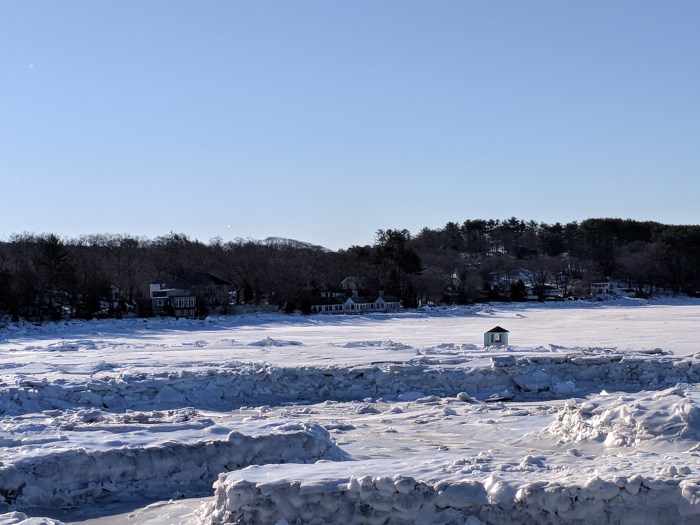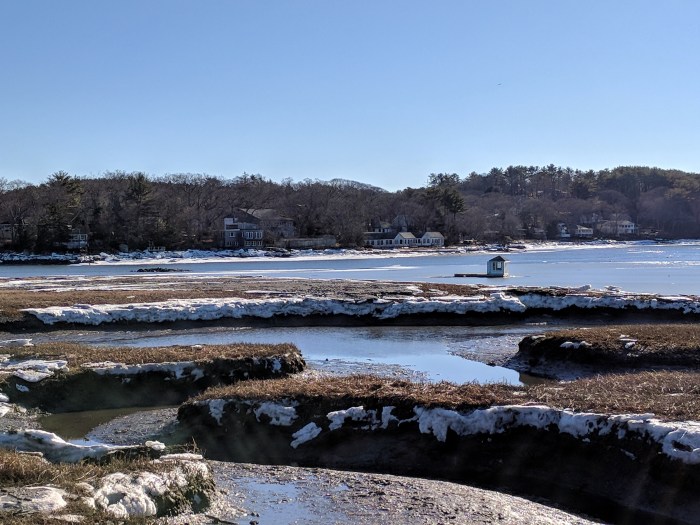Pretty reflections at Little River

My View of Life on the Dock
Pretty reflections at Little River


Little River is so pretty and there is always something to see.

Lily Pond, snowy day West Gloucester
The Lily Pond and the Little River host a small, but resilient population of river herring. These fish, alewives and blueback herring, migrate from the ocean to the Lily Pond, spawn and then return to the sea. The young fish head downstream in late summer. This is one of the few “runs” remaining on the North Shore, and also one of the oldest in the commonwealth. We would like to know more about when and how many fish travel upstream every year. You can help us by volunteering to count fish as they migrate upstream to the Lily Pond from the Little River.
River herring provide important forage for cod fish, bluefish, tuna and striped bass….all important commercial, recreational and sport fish for the City of Gloucester. Each spring the City of Gloucester hosts a river herring count at the top of the fish ladder by the West Gloucester Water Filtration Plant. Volunteers monitor the once a year spawning run from the Atlantic Ocean This is a wonderful activity for families, scouts, home schoolers, youth and adult groups….. suitable for all ages!
Volunteering is simple and requires as little as ten minutes of your time.
The count runs from April 1st to May 30th .
There will be an informational training session held on Monday, March 25, 2019 at 6 PM in the first floor conference room at 19 Harbor Loop, Gloucester, and a field training session on Saturday March 30 at 10 AM at the West Gloucester Water Filtration Plant at 372 Magnolia Ave, Gloucester.
If you would like to count fish in Gloucester, contact:
Peter Seminara, Gloucester Shellfish Constable and Alewife Warden at the Shellfish Department at (978) 325-5248, by cell phone or text at (978) 949-1223, or by email at pseminara@gloucester-ma.gov.
Such a peaceful day on Wednesday afternoon had to stop and take a photo of one of my many favorite spots.


Here is Little River at high tide in August

Little River at low tide January 22, 2019

Beautiful morning on Saturday at Little River

It’s a little too cold and a little too early in the season for the Alewife to run, yet despite today’s 44 degree temperature, Gloucester’s new shellfish warden Tammy Cominelli shares that nine were counted from the Little River’s brand new counting station on Saturday!
Today marked the official opening of the station with Mayor Sefatia and members of SumCo eco contractors, NOAA, and the Mass Division of Marine Fisheries in attendance.
 Tammy Cominelli (Gloucester Shellfish Warden), John Catena (NOAA Fisheries Restoration Center), Mayor Sefatia Romeo Theken, Anna Macan (NOAA Fisheries Communications), Jen Goebel (NOAA Fisheries Communcations), Max Schenk (City of Gloucester Health Department), Michael Pentony (NOAA Fisheries – Greater Atlantic Regional Administrator), and Travis Sumner (SumCo co-founder).
Tammy Cominelli (Gloucester Shellfish Warden), John Catena (NOAA Fisheries Restoration Center), Mayor Sefatia Romeo Theken, Anna Macan (NOAA Fisheries Communications), Jen Goebel (NOAA Fisheries Communcations), Max Schenk (City of Gloucester Health Department), Michael Pentony (NOAA Fisheries – Greater Atlantic Regional Administrator), and Travis Sumner (SumCo co-founder).
* Unfortunately, I did not get everyone’s name. Please let me know if you know the names of the gentleman in the far back row and the gentleman to the far right. Thank you!
 Tammy Cominelli, Gloucester’s new Shellfish Warden, checking the water temperature.
Tammy Cominelli, Gloucester’s new Shellfish Warden, checking the water temperature.
* * *
In Massachusetts, the Alewife run between late March through May (when the water temperature is 51 degrees) and Blueback Herring run from late April through June (57 degrees); both species use the Little River to spawn at the freshwater Lily Pond.
The river herring begin their spring journey by swimming from the Atlantic Ocean, traveling through the Little River brackish, marshy basin.
River herring travel upstream to the little pool just below the Lily Pond, where they then swim up the new ladder, called an Alaskan sea pass, to spawn.
https://www.instagram.com/p/BhEmfEFF2Dj/
Here the adults will stay for about three to six weeks. Unlike salmon, which spawn and die, river herring that survive spawning take the return trip back to the sea.
Lily Pond snowy spring day
After the baby herring hatch, they live at the Lily Pond anywhere from one to three months. Once they have grown large enough, the young herring begin their journey to the Atlantic Ocean, first migrating down to the Little River basin, which is a mixture of both fresh and sea water, and then slowly out to the open sea to join large schools of Alewife and Blueback Herring.
River herring return to their home river to spawn once they become adults, in three to five years.

 At Little River on high tide before the snow melted, the reflection was so clear.
At Little River on high tide before the snow melted, the reflection was so clear.
A photo journal after the storm documenting and comparing a few iconic and sweeping Gloucester vistas on January 7, 2018, when all was white ice frozen, and again after the Great Thaw on January 13 2018.
Gloucester Motif- the house boat in view just before the turn off at Nichols

The Little House boat in the great frozen salt marsh reminded me of a mash up of two of Virginia Lee Burton’s children’s picture books inspired by Gloucester — Little House and Katy and the Big Snow. Here’s the little floating houseboat after the thaw at low tide January 13, 2018.

At high tide earlier in the day, January 13

Good Harbor Beach drive by three days after the storm
Good Harbor Beach salt marsh drive by one week after the storm and great thaw
Below the read more break: additional winter comparison photos (icebergs on the marsh by Lobster Land, Good Harbor Beach parking lot, Good Harbor Beach salt marsh, Stoney Cove pier at Little River & Annisquam River)
Continue reading “Little houseboat in the great frozen salt marsh #Gloucester MA”
The Golden Hour


Have you noticed how high the tide has been?


Come one come all
Thursday, 2:00 pm
Little River on Route 133, Gloucester


Little River is becoming one of my many favorite places to photograph. As the sky was so blue and marsh very green it made for a peaceful place to think.

